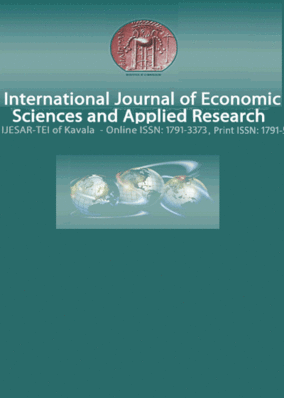Structural Breaks and Finance-Driven Growth Hypothesis in ECOWAS : Further Empirical Evidence
Part of : International Journal of Business and Economic Sciences Applied Research ; Vol.7, No.3, 2014, pages 63-80
Issue:
Pages:
63-80
Abstract:
This study makes a cross sectional case in investigating the validity, or otherwise, of the financedriven growth hypothesis in the ECOWAS countries using annual data from 1970 to 2008 for seven countries namely: Burkina Faso, Cote d'Ivoire, The Gambia, Ghana, Nigeria, Senegal and Togo. In contrast to earlier studies on developing countries, this study specifically tests for the possibility of structural breaks/regime shifts in the finance-growth long run relationship by employing the Gregory and Hansen (1996) residual based test which accounts for endogenous structural break. While the Gregory-Hansen structural break cointegration result confirms the existence of cointegration relationships among the selected countries despite the breakpoints, the Granger-causality test result indicates a general pattern of causality running from financial development to economic growth in most of the countries. Also, the striking feature of the result of our estimated growth model generally lends credent to the importance of financial development in explaining growth dynamics among the selected countries, thus reinforcing the finance-driven growth hypothesis.
Subject:
Subject (LC):
Keywords:
Financial development, Economic growth, Structural break, Cointegration
Notes:
JEL Classification: B23, C31, C51, F36, G15
References (1):
- Ang, J.B., 2008, Economic development, pollutant emissions and energy consumption in Malaysia, Journal of Policy Modelling, 30, pp. 271-278.Antonios Adamopoulos, 2010, Financial development and economic growth an empirical analysis for Ireland, Internationaljournal of Economic Sciences and Applied Research 3, 1, pp. 75-88Bagehot, Walter, 1873, Lombard Street. Homewood, IL: Irwin.Banerjee, Α., Lumsdaine, R. and Stock, J., 1992, Recursive and sequential tests of the unit-root and trend-break hypotheses: Theory and international evidence, Journal of Business and Economic Statistics, 10, 3, pp. 271-287.Baochen, Y. and Shiying, Z. 2002, Study on cointegration with structural changes, Journal of Systems Engineering, 17, 1, pp. 26-31.Demetriades, Panicos and Hussein, Khaled, 1996, 'Does Financial Development Cause Economic Growth? Time Series Evidence from Sixteen Countries', Journal of Development Economics, 51, 2, pp. 387-411.Dickey, D., Fuller, W., 1979, Distribution of the estimators for autoregressive time series with a unit root, Journal of the American Statistical Association, 74, pp. 427-431.Dritsakis, N. and A. Adamopoulos, 2004, 'Financial development and economic growth in Greece: An empirical investigation with Granger causality analysis', International Economic Journal, 18, 4, pp 547-559.Dritsakis, N., 2012, 'Structural Breaks, Cointegration and the Demand for Money in Greece', The IUP Journal of Applied Economics, 11, 3, pp. 1-17Engle, R. and Granger, C, 1987, Cointegration and error correction: representation, stimation, testing. Econometrica, 55, pp. 251-276.Goldsmith, Raymond W., 1969, Financial Structure and Development, New Haven, CT:Gregory, A. and Hansen, B., 1996, Residual-based tests for cointegration in models with regime shifts, Journal of Econometrics, 70, pp. 99-126.Gregory, Α., Nason, J. and Watt, D., 1996, Testing for structural breaks in cointegrated relationship, Journal of Econometrics, 71, pp. 321-341.Gurley, John G. and Shaw, E.S., 1955, 'Financial Aspects of Economic of Economic Development', American Economic Review, 45, 4, pp. 515-38.Hansen, B., 1992, Tests for parameter instability in regressions with 1(1) processes, Journal of Business and Economics Statistics, 10, pp. 321-335Johansen, S., 1988, Statistical analysis of cointegration vectors, Journal of Economic Dynamics and Control, 12, pp. 231-254.Johansen, S., 1991, Estimating and hypothesis testing of cointegration vectors in Gaussian vector autoregressive models, Econometrica, 59, 6, pp. 1551-1580.Johansen, S. and Juselius, K., 1990, Maximum likelihood estimation and inference on cointegration with applications to the demand for money, Oxford Bulletin of Economics and Statistics, 52, pp. 169-210.Levine, 2004, 'Finance and Growth: Theory and Evidence', NBER Working Paper 10766, Cambridge, Massachusetts: National Bureau of Economic Research.Levine, R, Loayza N. and Beck. T., 2000, 'Financial intermediation and growth: Causality and causes', Journal of Monetary Economics, 46, pp. 31-77.Luintel, K.B., Khan, M., Arestis, R, Theodoridis, K., 2008, Financial structure and economic growth, Journal of Development Economics, 86, pp. 181-200.McKinnon, Ronald I., 1973, Money and Capital in Economic Development, Washington, DC: Brookings Institution.MacKinnon, J. G., 1991, Critical values for cointegration tests. In R. F. Engle and C. W. J. Granger (eds), Long-run Economic Relationships: Readings in Cointegration, Ch. 13, pp. 267-76. Oxford: Oxford University Press.MacKinnon, J., Haug, A. and Michelis, L., 1999, Numerical distribution functions of likelihood ratio tests for cointegration, Journal of Applied Econometrics, 14, pp. 563-577.Newey, W.K., 1994, The Asymptotic Variance of Semiparametric Estimators, Econometrica, 62, pp. 1349-1382.Omisakin, O., Adeniyi, O. and Oyinlola, Α., 2012, Structural breaks, parameter stability and energy demand modeling in Nigeria, International Journal of Economic Sciences and Applied Research, 5, 2, pp. 129-144.Patrick, Hugh T., 1966, 'Financial Development and Economic Growth in Underdeveloped Countries', Economic Development and Cultural Change, 14, 2, pp. 174-187.Perron, P. and Vogelsang, T, 1992, Nonstationarity and level shifts with an application to purchasing power parity, Journal of Business and Economic Statistics, 10, 3, pp. 301-320.Pesaran, M., Hashem, M., Smith, R. and Akiyama, T, 1998, Energy demand in Asian developing countries, Oxford University Press for the World Bank and Oxford Institute for Energy Studies.Philips, P., 1986, Understanding spurious regression in econometrics, Journal ofEconometrics, 33, pp. 311-340.Phillips, P. and Ouliaris, S., 1990, Asymptotic properties of residual-based test for cointegration, Econometrica, 58, pp. 165-193.Phillips, P. and Perron, P., 1988, Testing for a unit root in time series regression, Biometrika, 75, pp. 335-346.Schumpeter, J. Α., 1912, Theorie der Wirtschaftlichen Entwicklungen, Duncker and Humboldt, Leipzig, Germany.Schumpeter, Joseph Α., 1912, Theorie der Wirtschaftlichen Entwicklung [The Theory of Economic Development]. Leipzig: Dunker & Humblot, translated by Redvers Opie. Cambridge, MA: Harvard University Press, 1934.Shaw, Edward S., 1973, Financial Deepening in Economic Development, New York: Oxford University Press.Toda, H.Y., Yamamoto, T., 1995, Statistical inference in vector autoregressions with possibly integrated process, Journal of Econometrics, 66, pp. 225-250.Zapata, H.O., Rambaldi, A.N., 1997, Monte Carlo evidence on cointegration and causation. Oxford Bulletin of Economics and Statistics, 59, pp. 285-298.Zivot, E. and Andrews, D., 1992, 'Further evidence on the great crash, the oil-price shock, and the unit-root hypothesis', Journal of Business and Economic Statistics, 10, 3, pp. 251-270.




